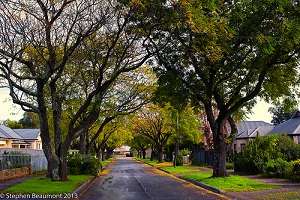Suburban green thumb denotes healthier residents

(Medical Xpress)—A first ever study by the University of Western Australia and Yale University has examined the relationship between neighbourhood greenness and weight status using satellite remote sensing.
Results showed that in neighbourhoods with greater greenness, there is an association with lower odds of being overweight or obese.
Obtaining self-reported height and weight (Body Mass Index) from 10,208 adults across three age segments, researchers were able to reference this against Landsat imagery sourced by Landgate.
Using a measure of greenness, NDVI (Normalised Difference Vegetation Index), map data was assigned lower numerical values for rock, sand, rooftops, and roads, and higher values for grassland, bushland and healthy green vegetation.
Bodies of water however were removed from the index.
UWA Centre for the Built Environment and Health, School of Population Health and Yale Centre for Perinatal, Paediatric, and Environmental Epidemiology Dr Gavin Pereira says using satellite remote sensing of vegetation allowed the research team to examine this relationship of weight status and greenness in an objective.
"Body weight is influenced by a range of factors such as genetics, diet and exercise," Dr Pereira says.
"[Previous] studies have also linked weight status to socioeconomic position and social networks. Unfortunately, the potential influence of the built and natural environment on weight status is not well understood."
The odds of being obese were 22 per cent lower for people in the greenest neighbourhoods in comparison to the least green when considering greenness as an absolute measure (mean greenness).
However, when considering variability of mean greenness, for example tree-lined streets connecting built destinations, this had the strongest impact on levels of obesity by a 25 per cent difference when comparing greenest versus least green.
"More striking was that the absolute level of greenness was not as important as the variability of greenness in a neighbourhood," Dr Pereira says.
"Our results might indicate the importance of well-connected tree-lined routes to walkable destinations such as stores and services.
"Equally, it might reflect the indirect health benefits from the presence of well-maintained parks with sufficient road access and parking."
While the study was able to assess greenness on a sheer numbers level, a limitation was the attractiveness of the greenness or 'quality'—known to influence behaviour in populations.
Dr Pereira says further research is necessary to identify the specific attributes of greenness that indirectly promote health.
Obesity in Australia continues to rise at a rate of 1kg per/m2 per decade and is an important modifiable risk factor in preventing cardiovascular disease, hypertension and type II diabetes.
















